The AMD Radeon R9 290 Review
by Ryan Smith on November 5, 2013 12:01 AM EST- Posted in
- GPUs
- AMD
- Radeon
- Hawaii
- Radeon 200
Compute
Jumping into pure compute performance, this is another scenario where the 290X shouldn’t throttle as much, and as such the performance differences between the 290 and 290X should be closer to what they are on paper. With compute workloads the ROPs aren’t being hit hard, so that’s power and thermal savings that lets both cards operate at close to their maximum boost clocks.
As always we'll start with our DirectCompute game example, Civilization V, which uses DirectCompute to decompress textures on the fly. Civ V includes a sub-benchmark that exclusively tests the speed of their texture decompression algorithm by repeatedly decompressing the textures required for one of the game’s leader scenes. While DirectCompute is used in many games, this is one of the only games with a benchmark that can isolate the use of DirectCompute and its resulting performance.
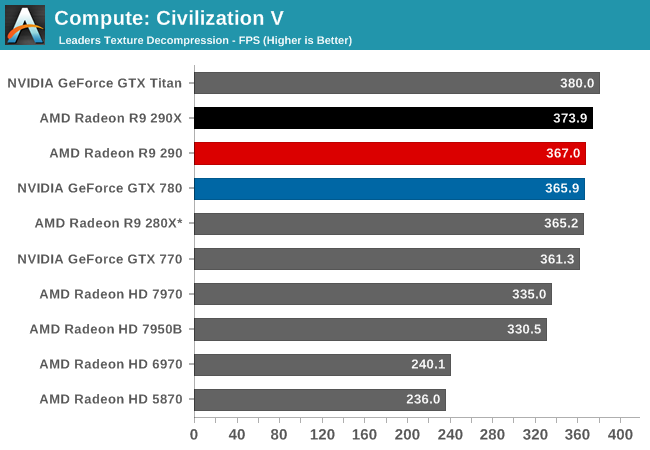
As with the 290X, Civ V can’t tell us much of value due to the fact that we’re running into CPU bottlenecks, not to mention increasingly absurd frame rates. The 290 is marginally slower than the 290X due to the lower clockspeeds and missing CUs, but minimally so.
Our next benchmark is LuxMark2.0, the official benchmark of SmallLuxGPU 2.0. SmallLuxGPU is an OpenCL accelerated ray tracer that is part of the larger LuxRender suite. Ray tracing has become a stronghold for GPUs in recent years as ray tracing maps well to GPU pipelines, allowing artists to render scenes much more quickly than with CPUs alone.
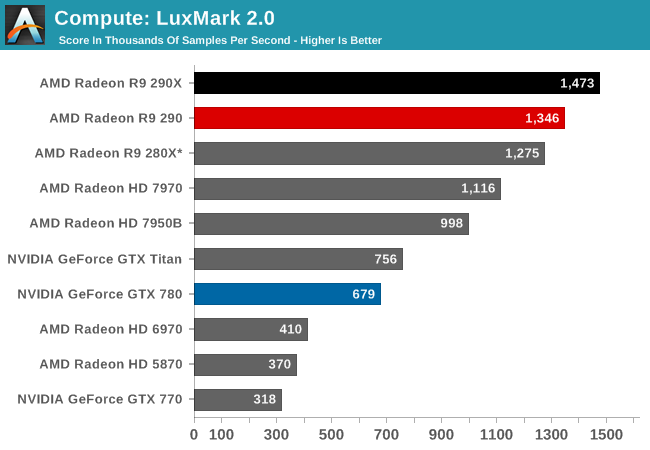
With both cards unthrottled and bound solely by shader performance, it’s an outright foot race for the Radeon cards. 290 trails 290X by around 9%, closely mirroring the difference in the CU count between the two cards. Though 290 is being very closely chased by the 280X, as Hawaii in general seems to have trouble getting the most out of its shader hardware on this benchmark.
Our 3rd compute benchmark is Sony Vegas Pro 12, an OpenGL and OpenCL video editing and authoring package. Vegas can use GPUs in a few different ways, the primary uses being to accelerate the video effects and compositing process itself, and in the video encoding step. With video encoding being increasingly offloaded to dedicated DSPs these days we’re focusing on the editing and compositing process, rendering to a low CPU overhead format (XDCAM EX). This specific test comes from Sony, and measures how long it takes to render a video.
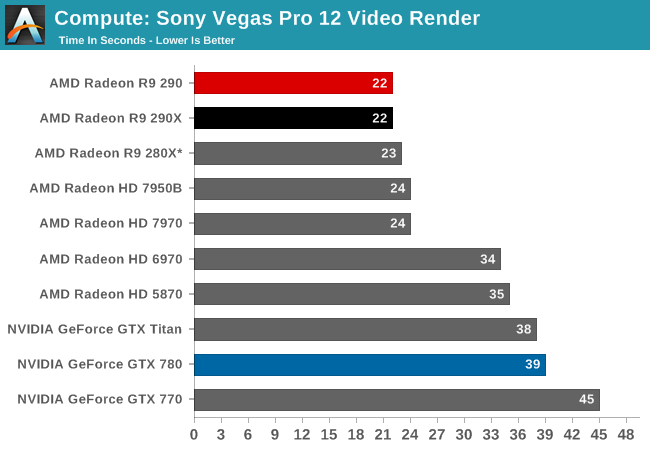
There’s not enough of a GPU performance difference between the two cards to matter with this test. Both tie at 22 seconds.
Our 4th benchmark set comes from CLBenchmark 1.1. CLBenchmark contains a number of subtests; we’re focusing on the most practical of them, the computer vision test and the fluid simulation test. The former being a useful proxy for computer imaging tasks where systems are required to parse images and identify features (e.g. humans), while fluid simulations are common in professional graphics work and games alike.
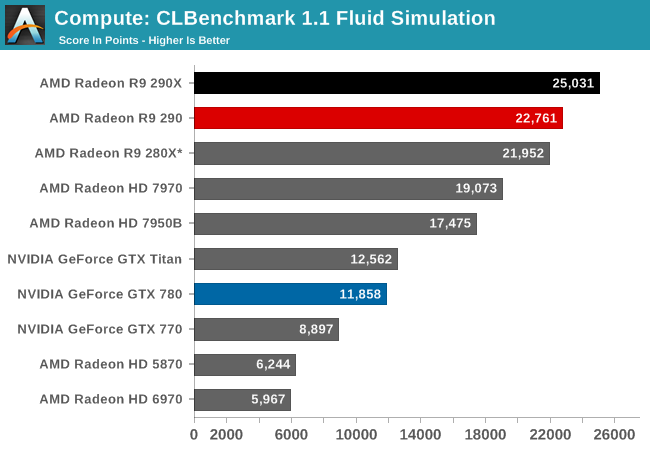

In the CLBenchmark fluid simulation the 290X and 290 take the top spots as expected, with the 290 trailing once more by 9%. However both Hawaii cards are still struggling with the computer vision benchmark, leading to the 290 being edged out by the 7970 of all things.
Moving on, our 5th compute benchmark is FAHBench, the official Folding @ Home benchmark. Folding @ Home is the popular Stanford-backed research and distributed computing initiative that has work distributed to millions of volunteer computers over the internet, each of which is responsible for a tiny slice of a protein folding simulation. FAHBench can test both single precision and double precision floating point performance, with single precision being the most useful metric for most consumer cards due to their low double precision performance. Each precision has two modes, explicit and implicit, the difference being whether water atoms are included in the simulation, which adds quite a bit of work and overhead. This is another OpenCL test, as Folding @ Home has moved exclusively to OpenCL this year with FAHCore 17.
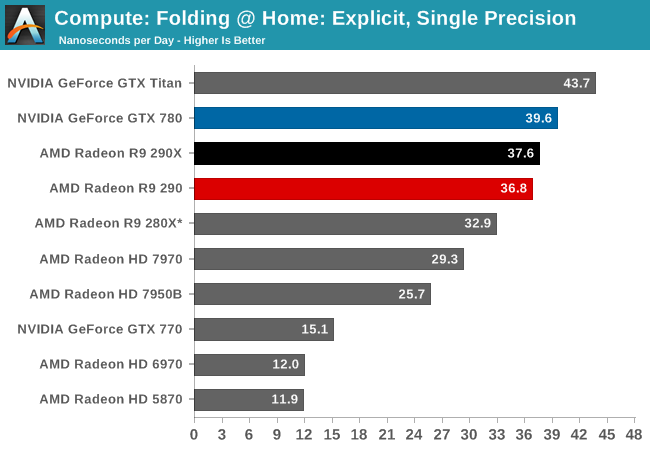
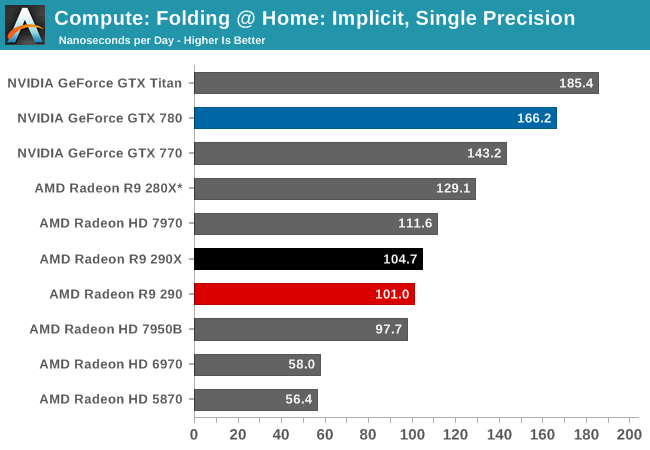
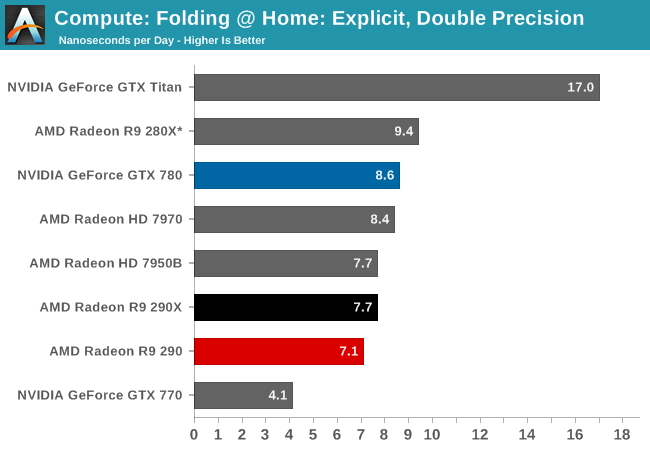
Generally Tahiti and Hawaii are strong performers in the GPU compute arena, but that isn’t of particular help to the 290 here, as it loses out to the GTX 780 in every mode. In single precision FAHBench has trouble putting Hawaii to good use at times, while double precision tests have the 1/8th DP rate 290 and 290X falling behind due to their lower than Tahiti DP throughput.
Wrapping things up, our final compute benchmark is an in-house project developed by our very own Dr. Ian Cutress. SystemCompute is our first C++ AMP benchmark, utilizing Microsoft’s simple C++ extensions to allow the easy use of GPU computing in C++ programs. SystemCompute in turn is a collection of benchmarks for several different fundamental compute algorithms, as described in this previous article, with the final score represented in points. DirectCompute is the compute backend for C++ AMP on Windows, so this forms our other DirectCompute test.
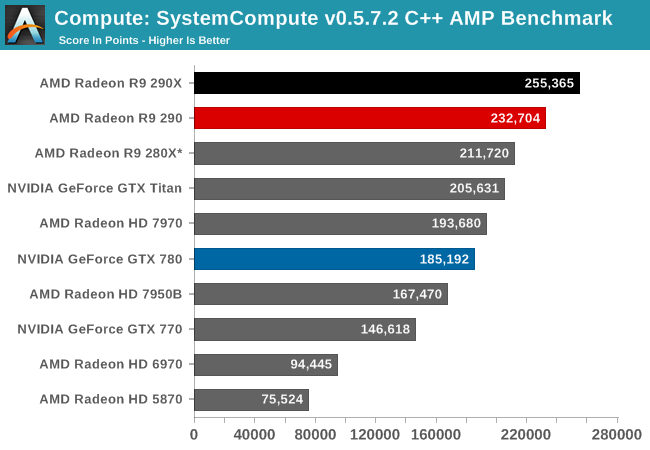
SystemCompute is another benchmark where 290 and 290X do not experience meaningful throttling, and as such are separated by more than what happens in our gaming benchmarks. In this case 290 yet again trails 290X by 9%, though it still enjoys a considerable lead over the GTX 780 and all other NVIDIA cards.










295 Comments
View All Comments
YazX_ - Tuesday, November 5, 2013 - link
This is the case for reference designs, i wouldnt expect that custom designs will suffer from noise and heat issues, as an example, 770 GTX reference temp under load is 80c, i have 770 gtx Gigabyte OC windforce3 andi have never seen the GPU temp reaching 65.290 for now is the best bang for the buck, gr8 job AMD, and for us, it means another price cut from Nvidia which is the best part in these competitions.
yeeeeman - Tuesday, November 5, 2013 - link
I think there is too much critic made on the subject of noise. You get a water block and the problem is solved. And you also pay less money for this combo, than what you would've pay'd for a GTX780.But, the thing that really strikes back from this review, is the unused potential of the 290X. Just imagine how it would run unlimited by its cooling system. I think it could hold its own against the comming 780Ti from nVidia.
And, we should stimulate AMD, because if it weren't for them, nVidia wouldn't ever dropped their prices. Now, they are even releasing the full GK110 core, at a smaller price than Titan.
TheJian - Tuesday, November 5, 2013 - link
So how many people you think there are running water? Also how much does that add to the cost of my shiny new hot card? Newegg isn't likely to be shipping water cooled cards by the millions...LOL. You are aware this is a REF NV card tested too right?Tomshardware seems to think noise and heat and how it runs IN GAMES after a period of time is an issue:
http://www.tomshardware.com/reviews/radeon-r9-290-...
"On the R9 290X we received from AMD, and in the seven games we tested, a 40% fan speed is good enough to average about 874 MHz. But when you’re actually gaming on a hot card (and not just benchmarking a cold one), our two-minute Metro: Last Light test suggests you’ll be spending more of your time in the upper-700 MHz range. In fact, in some titles, you’ll dip under 1000 MHz before even getting out of the menu system and into the action (Arma and BioShock).
You could call that questionable marketing. After all, the only way you’ll actually see a sustained 1000 MHz is if you either let the R9 290X’s fan howl like a tomcat looking for action or play platform-bound games."
How fast will these be after running a few hours in game? Or even 1hr? Most won't purchase water for any gpu so they'll be dealing with it as it is or with a better fan at some point (assuming OEM's get them soon):
"AMD’s scheme undoubtedly suffers a lack of clarity, and after piling praise onto the R9 290X’s value story, I now have to hope that Nvidia doesn’t follow AMD down this muddy little rabbit hole."
I hope they don't follow AMD and release a driver tomorrow doing the same crap too. But if I was them that is EXACTLY what I'd do in response along with videos everywhere explaining this should not be done, "but we have to do the same crap the other guys pull to beat us and when pulling this crap, you can clearly see there is no reason for us to drop prices agian" :) Or something like that...LOL. I really think AMD is going to be hurt by people buying the first rev and complaining all over forums about their silent PC (or nearly noise free) sounding like a jet engine now. Also as toms points out, are people really going to get the full perf while playing for longer than COLD periods that reviews bench under? A lot of people game for HOURS and they noted it slowing down even in menus before even playing the actual game. How does this card affect the rest of the temps in your PC during hours of playing? How does a gpu temp of 94 affect the PC vs. 81 for NV? I'll take 81 thanks.
1H4X4S3X - Tuesday, November 5, 2013 - link
Does anyone remember Ryan Smith's review of the even louder GTX 480?Anyone who can't see the bias is blind himself.
Drunktroop - Tuesday, November 5, 2013 - link
You treat FurMark as a more meaningful/real-life test than Crysis 3?silverblue - Tuesday, November 5, 2013 - link
Shh.The simple fact is, whilst incredibly fast, this baby needs modding with a better cooling solution. Early adopters are usually hit the hardest, so I'd recommend waiting until customised cards hit the shelves. A GTX 780-style cooler would be very interesting indeed.
Ryan Smith - Tuesday, November 5, 2013 - link
Which is actually why we threw in the GTX 480 in our charts for this one, to offer some perspective. The GTX 480 is quieter than the 290.chizow - Tuesday, November 5, 2013 - link
And certainly you must account for the possibility that expectations and tolerances change over time right? Read the 580 review and you will see he says it is basically "Fermi Done Right", setting the new standard for high-end temps and cooling. The 580 design put a ring on the fan to reduce the whine on the fan, so to go back to something as shrill and annoying is easily understood as taking a step in the wrong direction.chizow - Tuesday, November 5, 2013 - link
To add to that, there was a time 60mm and 80mm high RPM fans were the norm on CPU coolers, no longer, I could never stand for one of those high-pitched coolers again now what we are spoiled with 120mm/140mm CPU fans or multiple fans on radiators.Drunktroop - Tuesday, November 5, 2013 - link
I think you should be ready for noise when the maker is not willing to disclose power figures?Too bad Hawaii for SFF gaming is a no-go.
From performance perspective it is unbeatable.